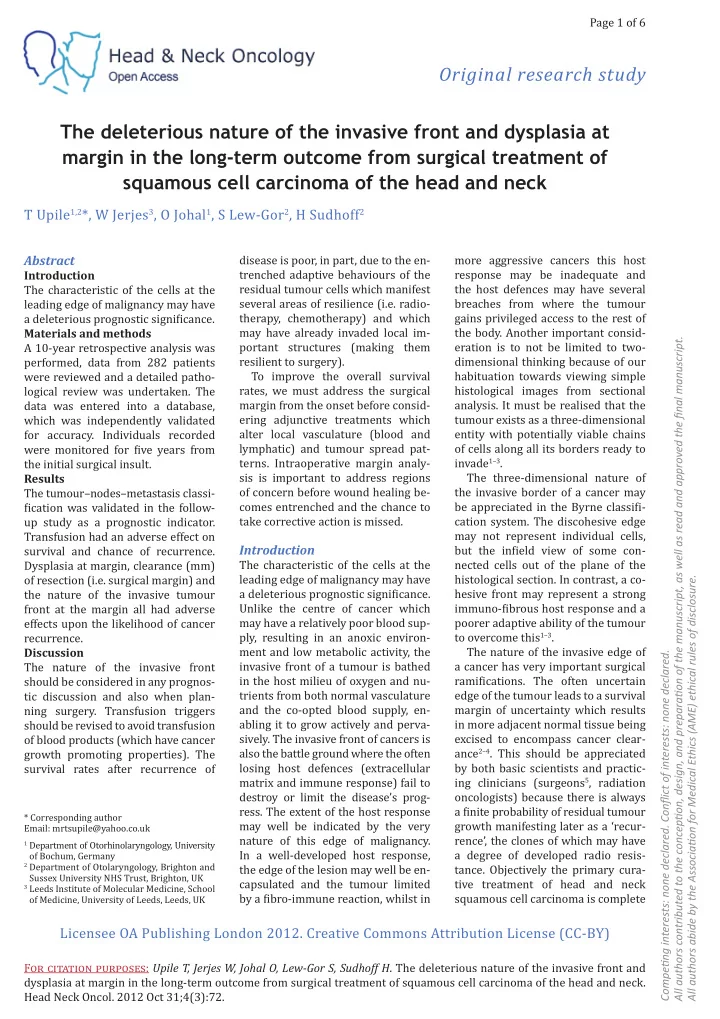

Page 1 of 6 Original research study The deleterious nature of the invasive front and dysplasia at margin in the long-term outcome from surgical treatment of squamous cell carcinoma of the head and neck T Upile 1,2 *, W Jerjes 3 , O Johal 1 , S Lew-Gor 2 , H Sudhoff 2 Abstract disease is poor, in part, due to the en- more aggressive cancers this host trenched adaptive behaviours of the response may be inadequate and Introduction residual tumour cells which manifest the host defences may have several The characteristic of the cells at the several areas of resilience (i.e. radio- breaches from where the tumour leading edge of malignancy may have therapy, chemotherapy) and which gains privileged access to the rest of a deleterious prognostic significance. may have already invaded local im- the body. Another important consid- Materials and methods All authors contributed to the conceptjon, design, and preparatjon of the manuscript, as well as read and approved the fjnal manuscript. portant structures (making them eration is to not be limited to two- A 10-year retrospective analysis was resilient to surgery). dimensional thinking because of our performed, data from 282 patients To improve the overall survival habituation towards viewing simple were reviewed and a detailed patho- rates, we must address the surgical histological images from sectional logical review was undertaken. The margin from the onset before consid- analysis. It must be realised that the data was entered into a database, ering adjunctive treatments which tumour exists as a three-dimensional which was independently validated alter local vasculature (blood and entity with potentially viable chains for accuracy. Individuals recorded lymphatic) and tumour spread pat- of cells along all its borders ready to were monitored for five years from terns. Intraoperative margin analy- invade 1–3 . the initial surgical insult. sis is important to address regions The three-dimensional nature of Results of concern before wound healing be- the invasive border of a cancer may The tumour–nodes–metastasis classi- comes entrenched and the chance to be appreciated in the Byrne classifi - fication was validated in the follow- take corrective action is missed. cation system. The discohesive edge up study as a prognostic indicator. may not represent individual cells, Transfusion had an adverse effect on Introduction but the infield view of some con - survival and chance of recurrence. The characteristic of the cells at the nected cells out of the plane of the Dysplasia at margin, clearance (mm) leading edge of malignancy may have histological section. In contrast, a co- of resection (i.e. surgical margin) and All authors abide by the Associatjon for Medical Ethics (AME) ethical rules of disclosure. a deleterious prognostic significance. hesive front may represent a strong the nature of the invasive tumour Unlike the centre of cancer which immuno-fibrous host response and a front at the margin all had adverse may have a relatively poor blood sup- poorer adaptive ability of the tumour effects upon the likelihood of cancer ply, resulting in an anoxic environ- to overcome this 1–3 . recurrence. ment and low metabolic activity, the The nature of the invasive edge of Discussion Competjng interests: none declared. Confmict of interests: none declared. invasive front of a tumour is bathed a cancer has very important surgical The nature of the invasive front in the host milieu of oxygen and nu- ramifications. The often uncertain should be considered in any prognos- trients from both normal vasculature edge of the tumour leads to a survival tic discussion and also when plan- and the co-opted blood supply, en- margin of uncertainty which results ning surgery. Transfusion triggers abling it to grow actively and perva- in more adjacent normal tissue being should be revised to avoid transfusion sively. The invasive front of cancers is excised to encompass cancer clear- of blood products (which have cancer also the battle ground where the often ance 2–4 . This should be appreciated growth promoting properties). The losing host defences (extracellular by both basic scientists and practic- survival rates after recurrence of matrix and immune response) fail to ing clinicians (surgeons 5 , radiation destroy or limit the disease’s prog- oncologists) because there is always ress. The extent of the host response a finite probability of residual tumour * Corresponding author may well be indicated by the very growth manifesting later as a ‘recur- Email: mrtsupile@yahoo.co.uk nature of this edge of malignancy. rence’, the clones of which may have 1 Department of Otorhinolaryngology, University In a well-developed host response, a degree of developed radio resis- of Bochum, Germany 2 Department of Otolaryngology, Brighton and the edge of the lesion may well be en- tance. Objectively the primary cura- Sussex University NHS Trust, Brighton, UK capsulated and the tumour limited tive treatment of head and neck 3 Leeds Institute of Molecular Medicine, School by a fibro-immune reaction, whilst in squamous cell carcinoma is complete of Medicine, University of Leeds, Leeds, UK Licensee OA Publishing London 2012. Creative Commons Attribution License (CC-BY) For citation purposes: Upile T, Jerjes W, Johal O, Lew-Gor S, Sudhoff H . The deleterious nature of the invasive front and dysplasia at margin in the long-term outcome from surgical treatment of squamous cell carcinoma of the head and neck. Head Neck Oncol. 2012 Oct 31;4(3):72.
Recommend
More recommend